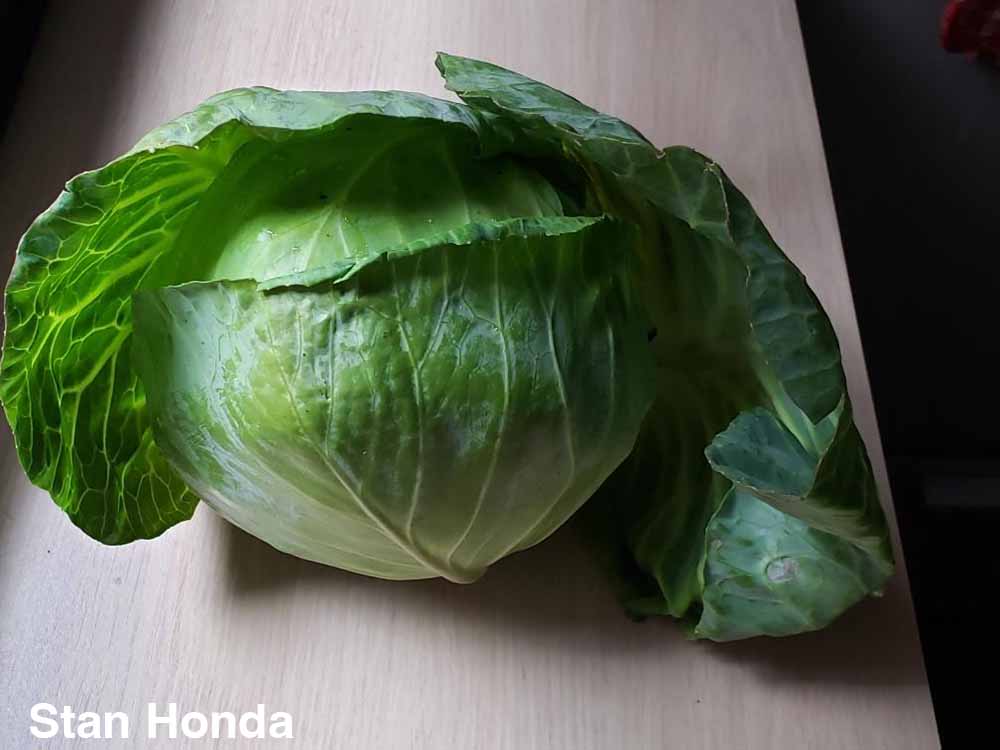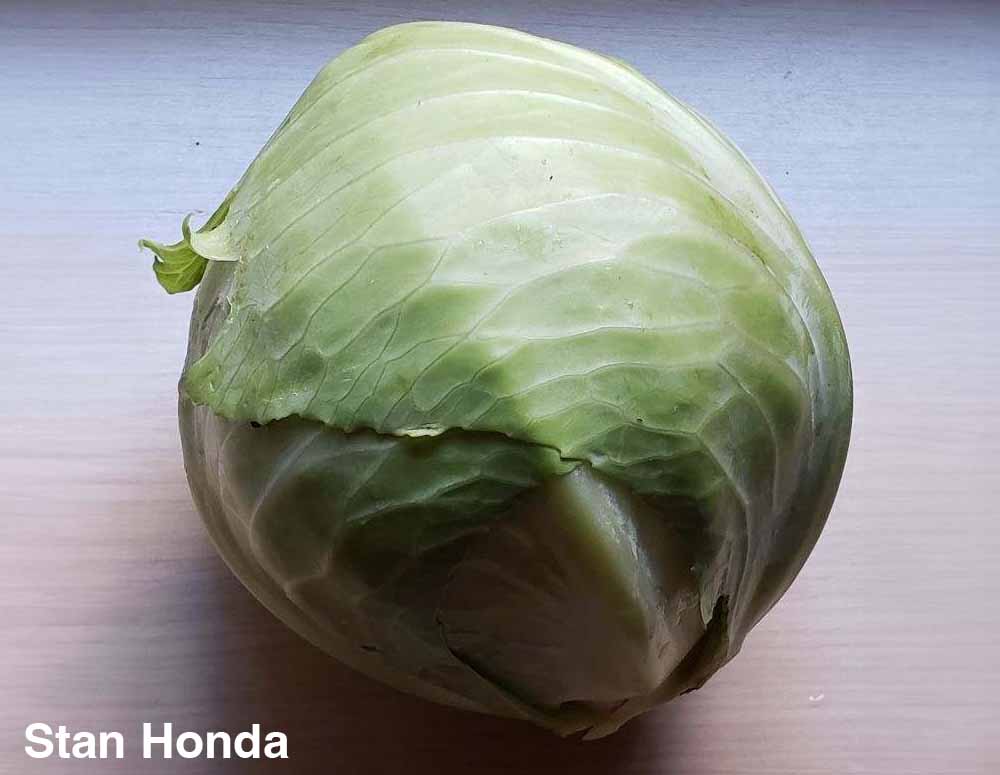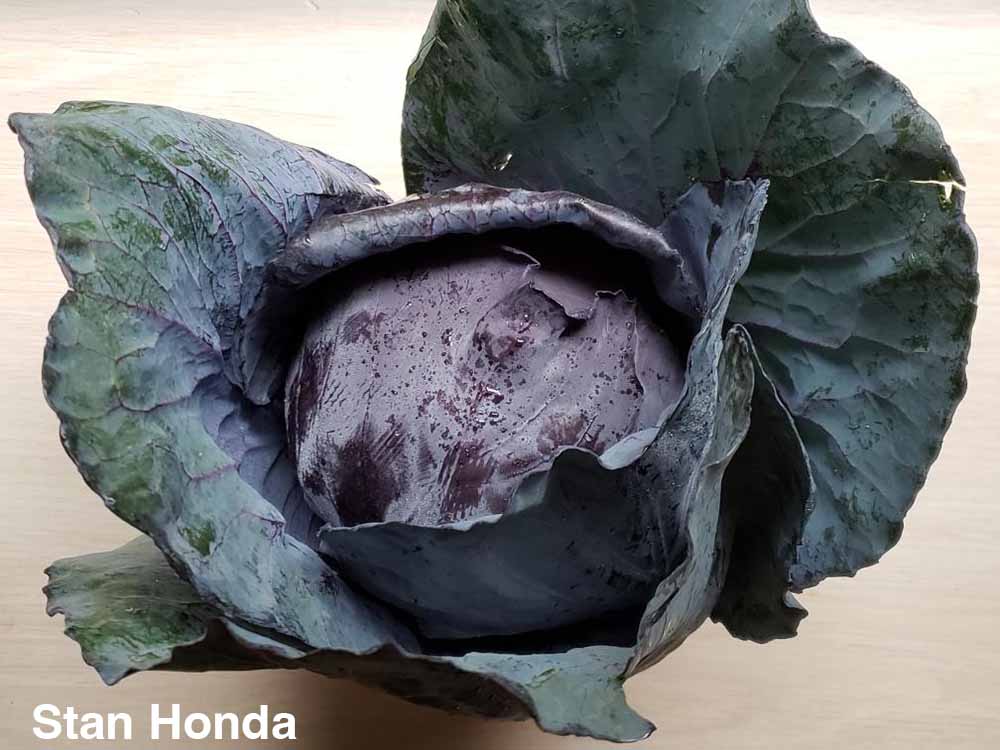CABBAGE & SPRING CABBAGE
Most people don’t get terribly excited when the cabbages arrive in our shares, but they should. Though many think of cabbages as boring, they are versatile, nutritious, and delicious, and have been used in a variety of amazing dishes every season all over the world.
For information on Chinese cabbage, Napa cabbage, or bok choy? Click here.
We get several varieties of cabbage in our shares, starting with small, pointy spring cabbages, which are called “sweetheart cabbages” in England. These smaller cabbages have a more delicate taste than later-harvested varieties but can be used in the same way. Sometimes, it’s nice to be able to use a whole cabbage in a single dish and not have leftovers.
By early fall, we start seeing fully mature varieties of red and green cabbages.
Varieties in Your Share

Bravo Cabbage

Primo Vantage Cabbage
(Early Cabbage variety)

Buscaro Red Cabbage
One of cabbage’s best attributes is its longevity. Cabbages last for several months—by the time your last cabbage is no longer fit to eat, the next CSA season is usually in sight. But it does need to be stored properly.
Storing: To store a whole cabbage, remove limp or yellowed leaves. Don’t wash it until you’re ready to use it; water seeps between the leaves and hastens decay. Put the whole cabbage in a plastic bag with holes in it, and put a small cloth or paper towel in there to absorb excess moisture. If stored properly, the cabbage will be fresh for up to two months, possibly longer. Check the cabbage every month or so and remove any wilted or discolored leaves.
To store a cut cabbage, wrap it tightly in plastic wrap. It won’t last as long, and if you don’t use it within two weeks, check it for mold or rot before using.
Freezing: If you don’t plan to use your cabbage in the foreseeable future, or if you have more room in your freezer than in your refrigerator, you can freeze your cabbage. When thawed, it won’t have the crispness needed for slaws or salad, but it’s still great for soups, stews, and cabbage rolls. In fact, some cooks freeze their cabbage the night before making cabbage rolls because it makes the leaves more pliable.
To freeze, put whole cabbage in plastic bags and pack cut or shredded cabbage in ziplocks or plastic wrap and put in freezer.
Preserving: You can also preserve cabbage by fermenting it as kimchi [link to kimchi recipe in Chinese cabbage (TBD)] or sauerkraut [link to “Simple sauerkraut” recipe, below], which don’t need to be refrigerated. You can also pickle your cabbage; you’ll find a recipe for quick-pickled cabbage that needs to be refrigerated here [link to “Quick pickled cabbage” below]; it will last about a month in the refrigerator.
And while we are not expert canners, there are plenty of fantastic canned pickled cabbage recipes out there! If you have a favorite, please share with us and we will add them here!
Cabbages have been used in every part of the meal, from appetizers to soups to sweet cabbage strudels. That’s not surprising—cabbages are cheap, easy to grow, long-lasting, and have a mild taste that can be incorporated into recipes without overpowering them. Cabbage leaves make great crudites, especially the red ones, and cabbages can be hollowed out to hold dips (use the insides for coleslaws).
But perhaps the most prevalent use of cabbage is coleslaw, which means “cabbage salad” in Dutch. This simple, no-cook salad takes only a few minutes to prepare and has endless variations. It’s colorful (especially if you use red cabbage) and tasty (especially if you pump up the flavor of the dressings). You’ll find a collection of coleslaws here
When you are ready to eat your cabbage, remove any outer leaves that are limp or yellow, until you get to leaves that are firm and fresh. Then put the cabbage on a cutting board and cut in half, then cut the cabbage into wedges, removing the solid core (the core can be chopped or pureed and used in soups). Rinse wedges under running water, as insects and worms often find their way to the inner leaves. Drain the cabbage in a colander, shaking it to remove as much water as possible. It will be easier to cut cabbage if you use a long, heavy knife.
To shred, place the cabbage a cut half or wedges on a chopping block and slice into thin ribbons.
This versatile vegetable lends itself to a wide variety of cooking methods. Or, you can forget cooking and eat it raw in salads and slaws.
Boiled: Some people turn their noses up at boiled cabbage because they’re turned off by the smell which can linger for days. The smell is caused by the release of sulfur dioxide gas, which expands when the cabbage is overcooked. On the other hand, boiled cabbage is delicious.
So if you’re boiling cabbage, do it quickly. Add a few inches of water to a pot and bring it to a full boil. Drop in cabbage in wedges, shreds, or pieces. Stir once, cover, and then let it boil for about 5 minutes. Stir again, then return to a boil for another 5 minutes, until the cabbage is soft. Drain immediately and dress with olive oil or melted butter.
Steamed: Cabbage can also be steamed; follow the directions for boiling but put the cabbage in a steamer or steaming insert placed over the water.
Microwaved: Cabbage cooks quickly in a microwave. Just put whole or chopped leaves in a microwave-safe dish and cook on high for a minute; if not fully softened, stir and cook for another minute. For wedges, cook for 2 minutes, then turn and cook for an additional minute.
Sautéed: To sauté cabbage, heat butter or oil in a skillet. Add onion or garlic if you wish and sauté until soft, then add the cabbage. It will soften in a minute or two, and very little of the cabbage odor is emitted. Season with salt, pepper, and your favorite herbs or spices.
Braised: To braise cabbage, follow the instructions for sautéing. When the cabbage is soft, lower the flame and add liquid to just cover—this can be water, milk, wine, tomato juice, even citrus juice. Let the cabbage simmer over a low flame for 20-30 minutes, stirring occasionally. The cabbage should absorb most of the liquid, but be careful not to let it all evaporate. Season to taste.
Caramelized: Caramelizing cabbage takes the braising process one step further. Usually, wedges of cabbage are caramelized, but it can be done with shreds or pieces as well. After sautéing with oil, keep cooking for 30-40 minutes—feel free to add a highly flavored sauce or oil in this step—tossing and turning frequently. After the cabbage has begun to color and most of liquid is gone, transfer to a baking dish and bake in a 400 F oven until the edges are brown and all the liquid is gone. The caramelizing process goes faster if you add a bit of sugar to the liquid.
Roasted: Preheat the oven to 425 F. Cut cabbage into wedges and brush the cut edges with olive oil or melted butter, and arrange in a baking pan. Sprinkle with herbs and spices, salt and pepper. Put the pan in the oven and roast for 15 minutes, then baste with the liquid that forms in the pan. Turn the wedges over and roast for an additional 15-20 minutes.
RECIPES
SOUPS. STARTERS & SIDES
- Cabbage soup
- Cabbage, potato & leek soup
- French cabbage soup with bechamel
- Marcella Hazan’s rice and smothered cabbage soup
- Sautéed cabbage, carrots & caraway
- Chinese-style cabbage and eggs (gluten and dairy free)
- Okonomiyaki (Japanese cabbage pancakes)
- Gujarati cabbage with coconut and potato
- Sweet and sour red cabbage
- Charred cabbage with butternut-miso mash
- Suspiciously delicious creamed cabbage
MAIN DISHES
- Stuffed cabbage (holopches)
- White beans and cabbage
- Pasta with caramelized cabbage, anchovies and breadcrumbs
- Black bean and cabbage rolls
- 15-minute cabbage-tofu dinner
- Pasta and potatoes with cabbage (Pizzoccheri)
- Choucroute garni
- Corned beef and cabbage
- Kapuska—Turkish cabbage stew
- Cabbage loaf
- Hungarian cabbage strudel
- Ethiopian cabbage
- Pancit
MISC
Cabbage is low-calorie, low-carb, low-sodium, and fat-free, but it delivers a load of nutritional benefits. Both raw and cooked, it is an excellent source of Vitamin C and Vitamin K. Cooked cabbage also contains manganese, Vitamin B6, folate (B9), and dietary fiber.
Interestingly, raw red cabbage contains somewhat more Vitamin C than the green and savoy varieties, while the greens and savoys are higher in Vitamin K.
Cabbages are easy to grow and do not require the best soils, the warmest temperatures, or full sun. They grow quickly and are among the first vegetables to mature in spring.
Cabbages are native to Europe and farmers learned to grow them as far back as 1,000 BCE. Ancient Greeks and Romans called them “the first vegetable” and they were staples in biblical times. One of the first vegetables to be cultivated, cabbages helped people feed themselves through winter before refrigerators were invented. By the Middle Ages, they were a staple throughout Europe, particularly in central and eastern Europe.
CONTRIBUTOR


